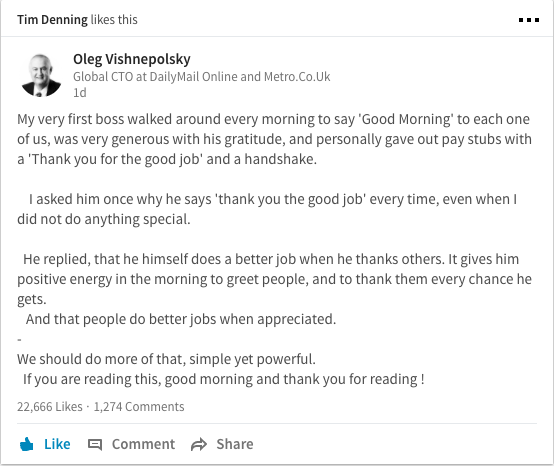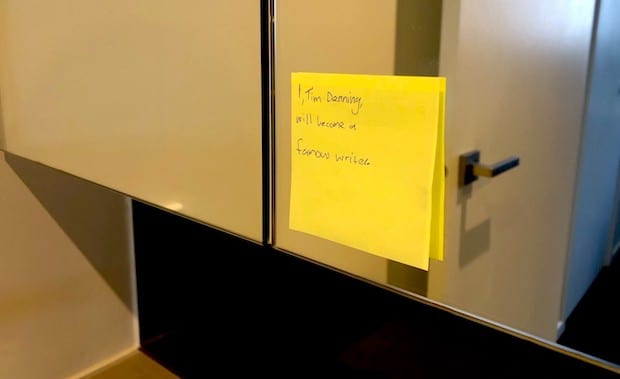Success Advice
The Insanely Simple Guide For Getting Noticed On Social Media.

Before we begin, the only reason I want you to get motived to use social media is so you can add value to people’s lives in some meaningful way. This advice is not about becoming some ridiculous influencer or building vanity metrics like followers.
Let’s begin.
Don’t hold back. Be real.
Authentic and vulnerable wins every time. Share the full story. Don’t be afraid to look like an idiot. Show the raw emotion in your stories. Just be you. This will get you noticed and make you stand out from all the fakeness that exists.
Make people feel.
Feel inspired.
Feel a sense of relief because you made them laugh.
Feel unhappy and want to change.
Feelings drive people to engage with you again.
Make it really simple.
When publishing text of any kind, don’t make your paragraphs any longer than three sentences. This style is easy on the eye and will bring more eyeballs to your content.
“The white space in between the black text is beautiful. Take advantage of it”
Less is more.
Try writing no more than 1500 words for a blog post. This forces you to get to the point and delete any filler. The need to be in-depth all the time is not required.
You’ll save time and keep it simple which is the goal.
Give everything away for free.
In the beginning, when you’re trying to get noticed and get somewhere, give it all away for free.
Why? Because no one’s paying money for someone’s advice that is not proven. Social proof is king in the online world and it takes a while to build.
Try no photos.
Video and pictures can sometimes subtract from the message. Some of the best posts that you’ll see online that help the writer get noticed are text only.

Try a text only post like this one.
Choose minimalistic photos.
Photos that are trying to say too much don’t work.
Photos that get to the point and are minimalistic in nature are powerful.
Before I forget, photos that look like stock images don’t work either. We’ve all seen tons of them and so they are uninspiring and too common.
Simplicity works.
You’ll see a common theme in this article.
“Simple works better than anything else I’ve tried”
Life is already complex enough and the individuals who are prepared to save us all time and keep things simple, are the ones who get noticed on social media.
Take complex topics and make them simple for the masses.
Make your content simple and easy to read.
The headline and feature image are where you should spend your time.
For blog posts on social media, you should spend the majority of your time on the headline and feature image. You want to disrupt people who are scrolling through their social media newsfeed with your content.
Word of warning: this does not mean you create click bait posts that aim to get people to click rather than add value to their life.
You want to be different but you do not want to try and trick people. Tricking people makes you a lair and that will get you noticed for all the wrong reasons.
Say it without ego.
Most content that gets’s ignored is full of ego. Trying to sound cool or bragging about what you have or know doesn’t work.
It’s an easy trap to fall into so be careful talking about yourself too much. Use personal experience and stories but put the focus in what people can learn, rather than how good you are.
Action orientated or inspiring works best.
Posts that give clear actions that work and deliver them in easy to follow steps work.
Posts that inspire people to make a change or take action work as well.
Why? Because these type of posts add value to our lives. We can get something out of them rather than just consuming them.
Collaborate with people who have audiences.
There are lots of people on social media that you can collaborate with so you can share their audience. Here are two strategies:
1. Email them and ask if you can collaborate on some content or if you can share each other’s posts.
2. Build a relationship with them via instant message services like Facebook Messenger and then ask them if you can tag them on specific posts.
Never tag anyone without permission.
Don’t overdo it or you’ll wear them out quickly.
Be kind.
We all start from nothing. When people reach out to you, respond to them. Inspire them. Help them where you can. Do that podcast interview. Write a guest post. Say thank you.
Kindness will be noticed. It will get you noticed because it’s so rare.
Support good causes.
Social media has lots of good causes. When you see one, use your influence to support it. I saw a girl recently in South Africa who held up a handwritten sign asking for a job and then took a photo. She needed a job and had nothing. I liked her vibe and wanted to support her cause.
I shared her photo and helped her get noticed. Not to get something in return, but to spread more good.
Not everything about social media is about you and getting noticed.
If you want to increase your productivity and learn some more valuable life hacks, then join my private mailing list on timdenning.net
Did You Know
How Skilled Migrants Are Building Successful Careers After Moving Countries
Behind every successful skilled migrant career is a mix of resilience, strategy, and navigating systems built for locals.

Moving to a new country for work is exciting, but it can also be unnerving. Skilled migrants leave behind familiar systems, networks, and support to pursue better job opportunities and a better future for their families. (more…)
Life
10 Research-Backed Steps to Create Real Change This New Year
This New Year could finally be the one where you break old patterns and create real, lasting change.

Every New Year, we make plans and set goals, but often repeat old patterns. (more…)
Change Your Mindset
The Silent Skill That Makes People Respect You Instantly
What truly earns respect and why most people go about it the wrong way

Everybody craves respect but not everyone earns it. Some people believe that a title, years of experience, or a position of authority automatically entitles them to respect. (more…)
Entrepreneurs
The Essential Skills Every Entrepreneur Needs In 2026
Success in the digital age isn’t about luck. It’s about mastering the skills that separate dreamers from doers.

When I was 22 years old, I started my first side hustle as a ghostwriter. (more…)
-

 Shift Your Mindset4 weeks ago
Shift Your Mindset4 weeks ago11 E’s That Define Every Great Leader And Why Most People Miss Them
-

 Did You Know3 weeks ago
Did You Know3 weeks agoThe Success Patterns You Inherited (And Didn’t Notice)
-

 Entrepreneurs3 weeks ago
Entrepreneurs3 weeks agoThe Essential Skills Every Entrepreneur Needs In 2026
-

 Business4 weeks ago
Business4 weeks agoThe Hidden Money Pit in Your Operations (and How to Use It)
-

 Change Your Mindset2 weeks ago
Change Your Mindset2 weeks agoHow to Turn Your Mind Into Your Greatest Asset (Instead of Your Enemy)
-

 Change Your Mindset2 weeks ago
Change Your Mindset2 weeks agoThe Silent Skill That Makes People Respect You Instantly
-

 Life1 week ago
Life1 week ago10 Research-Backed Steps to Create Real Change This New Year
-

 Tech1 week ago
Tech1 week agoWhat’s in a Name? How to Get Your Domain Right




















2 Comments